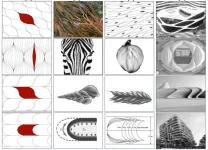(Press-News.org) Patients taking sulthiame, a drug currently in use for epilepsy, experienced a reduction in their symptoms of obstructive sleep apnoea (OSA), according to results of a clinical trial presented at the European Respiratory Society (ERS) Congress in Vienna, Austria [1].
Patients with OSA often snore loudly, their breathing starts and stops during the night, and they may wake up several times. Not only does this cause tiredness, but it can also increase the risk of high blood pressure, stroke, heart disease and type 2 diabetes. OSA is very common, but many people do not realise they have the condition.
The new research was presented by Professor Jan Hedner from Sahlgrenska University Hospital and the University of Gothenburg in Sweden. He said: “The standard treatment for obstructive sleep apnoea is sleeping with a machine that blows air through a face mask to keep the airways open. Unfortunately, many people find these machines hard to use over the long term, so there is a need to find alternative treatments. We also a need better understanding of the underlying mechanisms in OSA to help clinicians give more personalised treatment.”
The trial was a double-blind, randomised, placebo-controlled trial – the gold-standard in medical research. It involved 298 people with OSA being treated at 28 different centres in Spain, France, Belgium, Germany and the Czech Republic. All the patients could not tolerate or refused to use continuous positive airway pressure (CPAP) machines or mouthpieces designed to keep the airways open.
The patients were assessed with polysomnography at the start of the trial, and after four weeks and 12 weeks in the study. Polysomnography measures breathing, levels of oxygen in the blood, heart rhythm, eye movements, brain and muscle activity during a night of sleep.
The patients were divided into four groups: 74 people took 100 mg of sulthiame daily, 74 took 200 mg, 75 took 300 mg and the remaining 75 took a placebo (dummy pill). Sulthiame is a drug that targets the respiratory system by inhibiting an enzyme called carbonic anhydrase and stimulating the upper airway muscles.
The people taking sulthiame had fewer pauses in their breathing and higher levels of oxygen in their blood during sleep. A measure of the frequency of respiratory pauses during sleep, called AHI3a [2], was 17.8% lower for patients taking the lowest dose, 34.8% lower for patients on the medium dose and 39.9% lower for patients on the highest dose. When researchers used another measure called AHI4, the effect of the treatment was close to a 50% reduction of respiratory pauses with more profound lowering of oxygen levels. OSA patients who had been feeling sleepy during the daytime also felt less so when they took sulthiame.
Side effects experienced by the people taking sulthiame, such pins and needles, headache, fatigue, and nausea, were generally mild or moderate.
Professor Hedner said: “People taking sulthiame in the trial had a reduction in OSA symptoms such as stopping breathing during the night and feeling sleepy during the day. Their average levels of oxygen in the blood were also improved with the treatment. This suggests that sulthiame could be an effective treatment for OSA, especially for those who find they cannot use the existing mechanical treatments.
“Although sulthiame is already available as a treatment for childhood epilepsy, we still need to carry out a phase III study to confirm the beneficial respiratory effects of this drug in a larger group of patients with OSA.”
Professor Sophia Schiza is Head of the ERS assembly on sleep disordered breathing, Professor of Respiratory and Sleep Medicine in the School of Medicine at the University of Crete, Greece, and was not involved in the research. She said: “Many of us know that we snore or that our partner snores. If snoring is accompanied by other symptoms, such as waking up often in the night, feeling fatigued and/or sleepy during the daytime, then it’s time to speak to a doctor. Because obstructive sleep apnoea increases the risk of serious health problems such as high blood pressure, heart and metabolic disease, it’s vital that we diagnose and treat the condition. Treatments are available, but because they don’t work for everyone, we need more ways to treat the disease, based on individualised diagnostic and treatment approaches.
“This is one of the first studies to suggest that a drug treatment could help some patients, and the results are promising. We need to continue testing sulthiame and other treatments to understand their long-term effects, including any side effects. For example, we’d like to see whether treatment can help with lowering blood pressure and preventing cardiovascular disease for people with OSA.”
END
Drug treatment shows promise for dangerous snoring condition, obstructive sleep apnea
2024-09-10
ELSE PRESS RELEASES FROM THIS DATE:
Experimental blood test predicts risk for developing COPD, other severe respiratory diseases
2024-09-10
A scientific team supported by the National Institutes of Health (NIH) has created a preclinical blood test to identify adults most likely to develop severe respiratory conditions, including chronic obstructive pulmonary disease (COPD). The blood test analyzes 32 proteins that scientists determined accurately predicted an adult with an increased likelihood for requiring medical care for or dying from severe respiratory illness. The risk score was based on lung health data collected from nearly 2,500 U.S. adults over a 30-year period. The findings were published ...
Girls may start puberty early due to chemical exposure
2024-09-10
WASHINGTON—Girls exposed to certain endocrine-disrupting chemicals (EDCs) may be more likely to start puberty early, according to new research published in Endocrinology, the flagship basic science journal of the Endocrine Society. EDCs mimic, block or interfere with hormones in the body's endocrine system.
There has been an alarming trend toward early puberty in girls, suggesting the influence of chemicals in our environment. Early puberty is associated with an increased risk of psychosocial problems, obesity, diabetes, cardiovascular disease, and breast cancer.
“We conducted a comprehensive screen of 10,000 environmental compounds ...
Innovative delivery, access to care necessary to increase health equity for rural patients with heart disease
2024-09-10
The American College of Cardiology’s Quality Summit 2024 will feature several poster presentations regarding rural health delivery and access to care that offer insights into innovative strategies to increase health equity for all heart disease patients. Research examines door-in-door-out and door-to-balloon (D2B) times for heart attack patients at critical access hospitals, improving door-to-thrombolytics for heart attack patients at rural hospitals, remote cardiac rehabilitation to increase access, and improving communications technology for EMS with STEMI patients in rural areas.
“Rurality creates unique challenges in delivering high quality cardiovascular ...
Study indicates delayed feedback enhances learning performance in individuals with traumatic brain injury
2024-09-10
East Hanover, NJ – September 10, 2024 – Kessler Foundation researchers have published a novel study exploring the effects of delayed feedback on learning in individuals with moderate-to-severe traumatic brain injury (TBI). The article, “Bypassing Striatal Learning Mechanisms Using Delayed Feedback to Circumvent Learning Deficits in Traumatic Brain Injury” (Doi: 10.1097/HTR.0000000000000947), was published online ahead of print on July 24, 2024, in The Journal of Head Trauma ...
PLOS and DTH-Lab partner to increase youth participation in science
2024-09-10
San Francisco, California, United States - The Public Library of Science (PLOS) and the Digital Transformations for Health Lab (DTH-Lab) today announced a strategic partnership between the organizations to increase youth participation in science to include mentorship opportunities, amplifying youth voices in scientific publishing and building a body of research in digital health citizenship with a mini-collection.
“This strategic partnership with DTH-Lab will ensure that youth is empowered ...
What’s really ‘fueling’ harmful algae in Florida’s lake Okeechobee?
2024-09-10
Lake Okeechobee is the largest lake in Florida and the second largest in the Southeastern United States. Over the past two decades, blooms of blue-green algae (Microcystis) have emerged in the lake and have been flushed into nearby urban estuaries, causing serious environmental and public health issues.
Excess nutrients from industries, agriculture and urban development – particularly nitrogen and phosphorus – are well-known causes of harmful algal blooms worldwide. Historically, Lake Okeechobee has only been considered to be impaired for phosphorus, ...
Soft cells: Rounded tile shapes echo those found in nature
2024-09-10
Tiles that fill two- and three-dimensional spaces with no gaps—including triangles, squares, hexagons, cubes, and other polyhedra—are typically designed with sharp corners and flat faces (straight edges). Gábor Domokos and colleagues explore soft and curved two- and three-dimensional tiles that completely fill space with a minimal number of sharp corners, which they term “soft cells.” The authors demonstrate how to soften polyhedral tiles by systematically deforming edges. The resulting shapes echo those found in nature, including river estuaries, zebra stripes, muscle tissue, and the chambers of seashells, including the Nautilus. Biological structures ...
Unravel Biosciences and SynGAP Research Fund (SRF) Announce clinical research to accelerate new and repurposed therapies for SYNGAP1-related disorders
2024-09-10
Mill Valley, CA – September 10, 2024 – The SynGAP Research Fund 501(c)(3) announced a collaboration with Unravel Biosciences, Inc., an AI-enabled therapeutics company, to initiate a clinical study aimed at generating primary clinical data, uncovering novel therapeutic targets, repurposing existing drugs, and stratifying SYNGAP1-Related Disorders (SRD) patients into subgroups based on their predicted response to selected drugs. This collaboration will utilize Unravel’s rareSHIFT™ discovery services and BioNAV™ AI platform to advance the development of targeted therapies for SRD.
As part of this ...
The Paul G. Allen Frontiers Group announces Allen Discovery Center for Neurobiology in Changing Environments
2024-09-10
SEATTLE, WASH.—September 10, 2024—Climate change is rapidly reshaping our oceans, stressing the nervous systems of marine organisms that have evolved over millions of years. Scientists now face a critical question: How do these environmental shifts affect these animals’ ability to sense and respond to their changing world?
To address this pressing issue, the Paul G. Allen Frontiers Group, a division of the Allen Institute, today announced the launch of the Allen Discovery Center (ADC) for Neurobiology in Changing Environments. This initiative, based at Scripps Institution of Oceanography at the University of California ...
Clinical hypnosis vs. cognitive behavioral therapy: What's better for managing hot flashes?
2024-09-10
CLEVELAND, Ohio (Sept 10, 2024)–Nonhormone options for hot flashes and other menopause symptoms are growing in popularity, especially for women who cannot take hormones due to health complications. Cognitive behavioral therapy and clinical hypnosis are common nonhormone treatment options. According to a new scoping review, however, one is more effective than the other. Results of the scoping review will be presented at the 2024 Annual Meeting of The Menopause Society in Chicago September 10-14.
Recognizing that a percentage of menopausal women cannot take hormone therapy either because of health restrictions, such as being a breast ...







